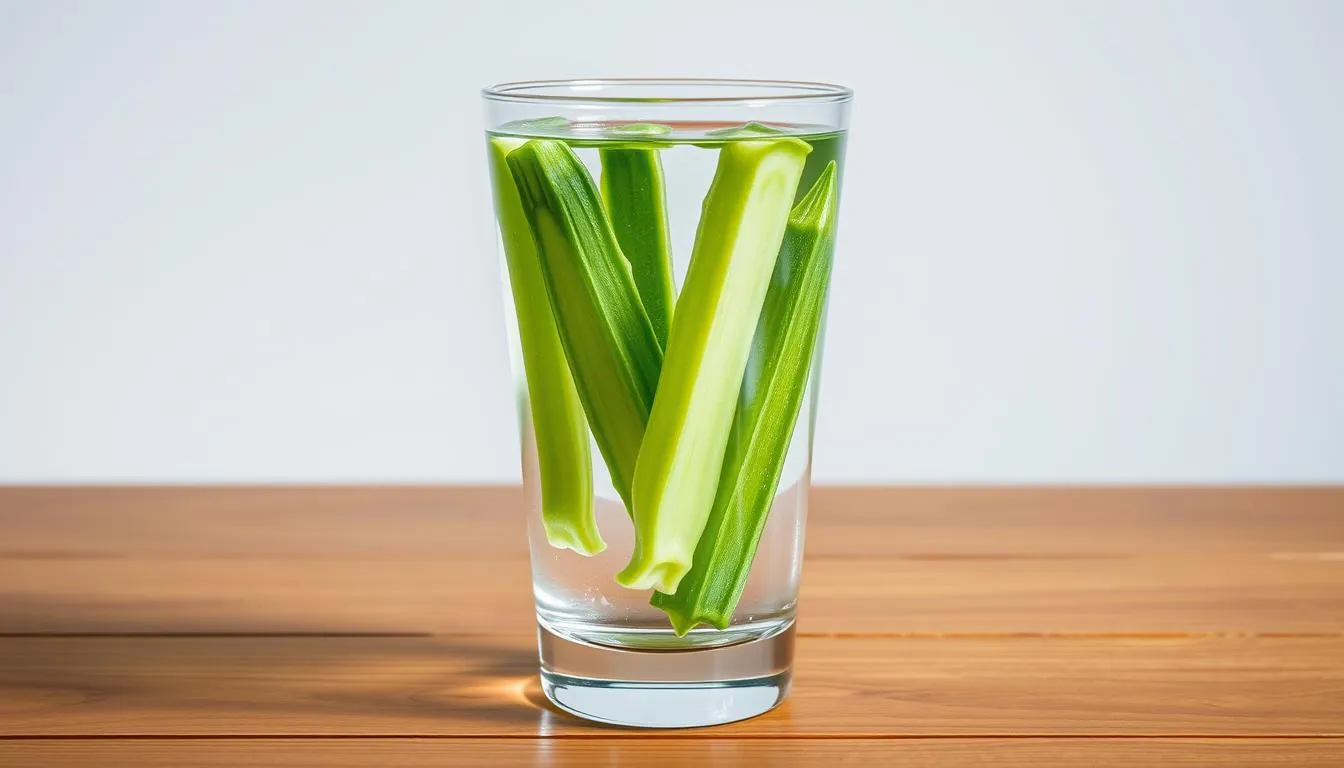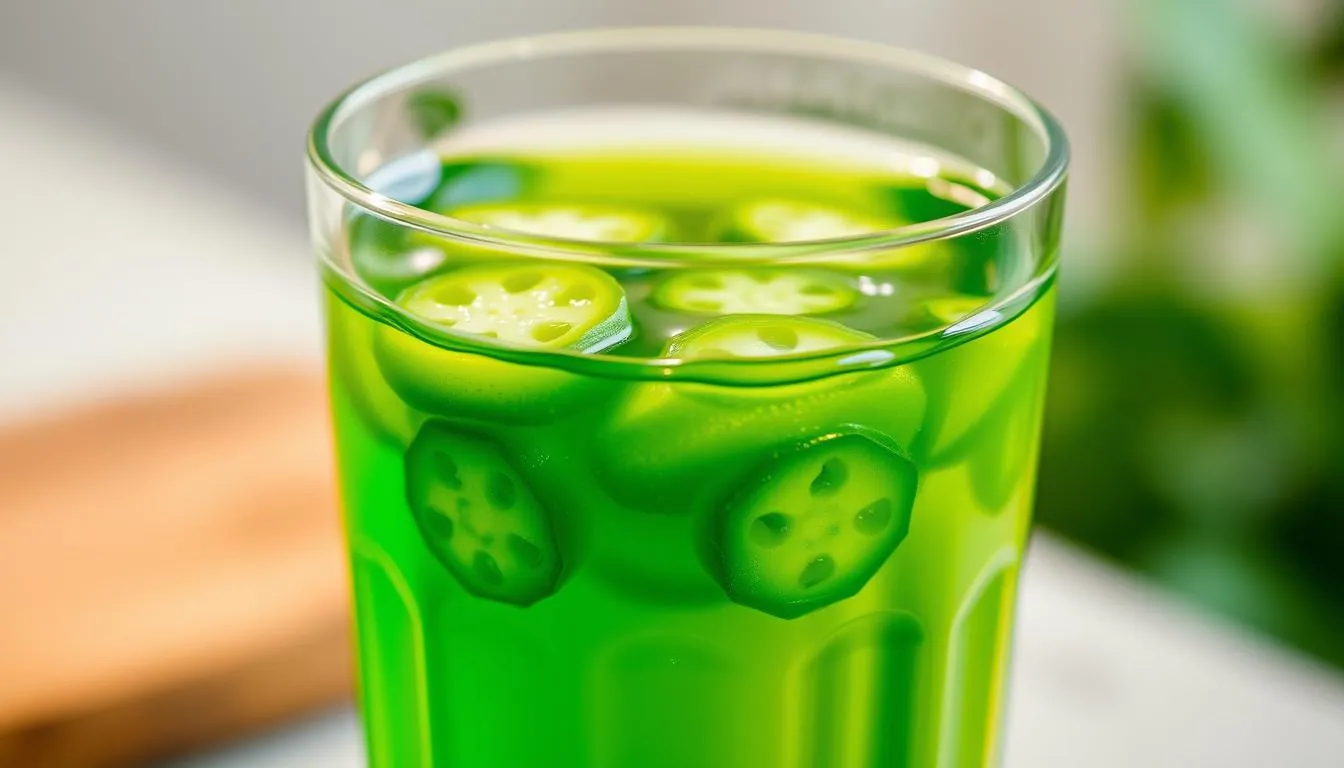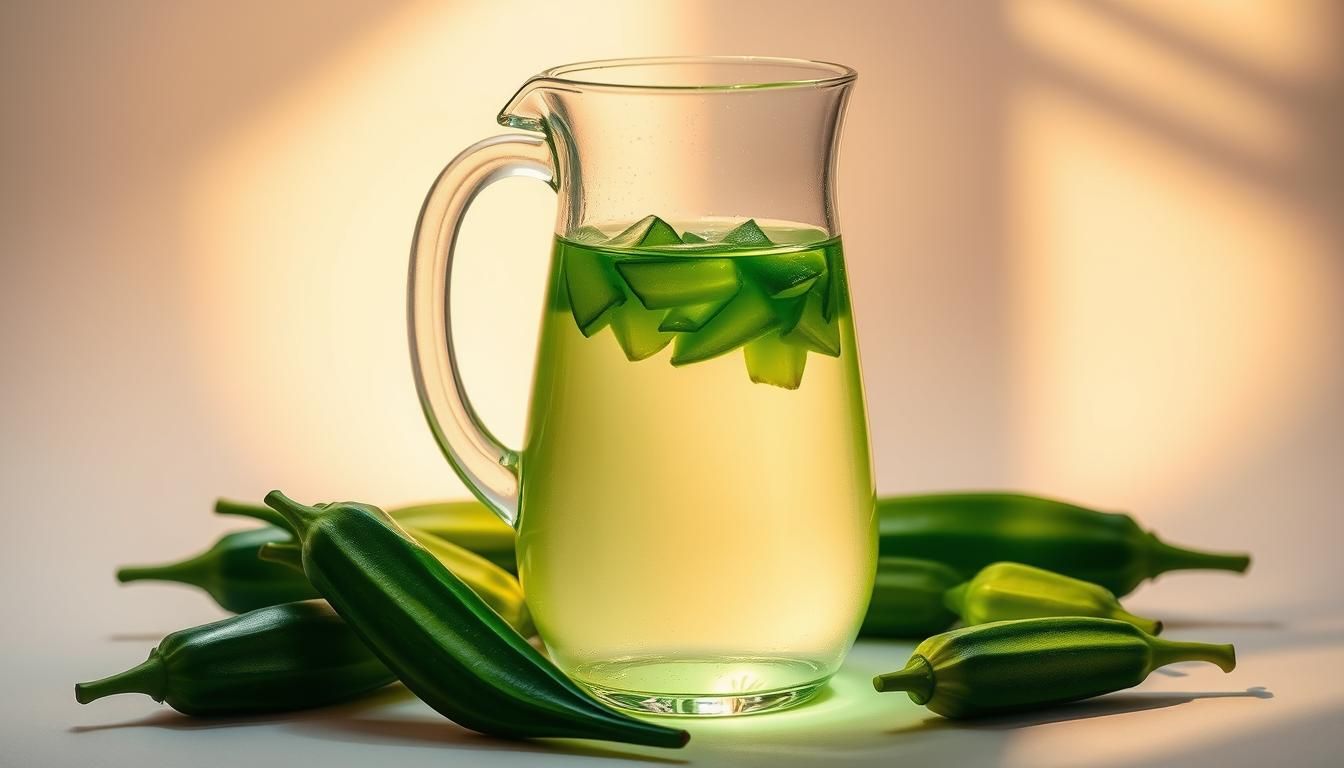I remember the first time I tried a viral health hack and felt both hopeful and unsure. You might be curious too—wanting a simple habit that supports your body without big changes. This guide meets that feeling with clear facts and gentle honesty.
We’ll walk through what this trend really offers and what is still mostly internet buzz. You’ll learn what’s in the infusion, how the texture might surprise you, and which early evidence points to real health benefits like digestion support and steady blood sugar. For comprehensive digestive wellness, explore fasting and gut health strategies and consider non-alcoholic wellness beverages for variety.
Expect practical tips that keep safety front and center. You’ll also see why eating the whole plant gives more complete nutrition than the infused drink, and who should be cautious.
Key Takeaways
- We explain what okra water detox means and what people claim it does.
- Learn which health benefits have early evidence versus pure trend hype.
- Know what the mucilage feels like and how that affects the drink.
- Simple, safe ways to try the drink and fit it into your routine.
- Who should avoid it and why the whole vegetable offers fuller nutrition.
What is okra water and why it’s trending as a “detox” drink
Sliced pods steeped in plain liquid create a slippery infusion that many find curious.
The process is simple: cut fresh okra pods and soak them in room-temperature water. Over a few hours the pods release a glossy mucilage. That gel-like layer gives the infusion its slick feel and makes the idea easy to share online.
What’s in the mucilage? It holds plant polyphenols, a touch of soluble fiber, and trace minerals like magnesium and zinc. Some vitamins and potassium can leach into the liquid, but most nutrients stay in the whole vegetable.
Researchers haven’t tested the drink extensively, so claims about broad health benefits remain early. Still, the modest antioxidant content and the soluble fiber explain why people link the trend to gentle gut support.
- Low-cost, low-effort way to try a plant-based habit.
- Best viewed as a small complement to eating whole pods for full nutrients.
How to make okra water (with a lemon twist) for a smoother sip
A quick evening ritual yields a chilled, easy-to-sip infusion the next day. This small-batch method keeps prep minimal and helps you test how the drink fits your routine.
Basic prep: Rinse and slice 2–3 okra pods, place the slices in a clean jar, and cover with about 200–250 ml of cold water. Refrigerate overnight so the mucilage can infuse fully.

Simple method: soak sliced whole pods overnight and strain
In the morning, strain the liquid through a fine mesh and chill before you sip. Cold temperature smooths the texture and keeps the flavor fresh.
Add lemon for flavor, vitamin C, and a lighter texture
Squeeze in a little lemon to brighten the taste and cut the slick mouthfeel. The citrus adds vitamin C and makes the drink more palatable for many people.
- Use a finer strainer and swirl the jar before pouring to even out the texture.
- If you prefer a subtler feel, shorten soaking okra to 6–8 hours or add extra cold water after straining.
- Aim for one small glass per day as a simple way to test how your body reacts; remember the whole vegetable still delivers more nutrition for long-term health.
Okra water detox
A modest habit like sipping a simple plant infusion may add subtle support for digestion.
Potential digestion support:
How mucilage can ease stool passage
The glossy mucilage in the infusion may coat the gut lining and make stool pass more smoothly. Many people notice a gentler bowel routine after trying a daily glass.

Blood sugar basics
A small amount of soluble fiber in the drink can slow carbohydrate absorption and may help blunt post-meal blood sugar spikes. Effects are modest; eating the whole pod gives a stronger impact on glucose and overall blood markers.
Antioxidant content
Polyphenols and a bit of vitamin C in the liquid add antioxidants that support general health. These compounds help protect cells and contribute to daily defenses in a simple, sippable form.
Weight management angle
Low in calories and slightly thick, the infusion can fit into weight goals by adding hydration and a mild sense of fullness. Keep expectations realistic: the full vegetable brings more fiber and nutrients than the liquid alone.
- Start slowly and note how your body reacts.
- Use the drink as a supportive habit, not a cure-all.
What the evidence actually says about drinking okra water
Current studies offer only a faint signal that the drink might help, not a clear answer.
Thin human research, small studies, and animal data — use cautious optimism.
Scientists have not tested the infusion directly in large trials. Most data come from small human studies on the whole vegetable and from animal experiments.

Small studies and animal work: early signals, not proof
Laboratory and animal results hint at positive effects. These include mild antioxidant activity and metabolic changes in controlled settings.
Human trials are few and small. That means we can be curious but should not assume broad health benefits from a daily glass.
Whole okra vs infused liquid: more fiber and nutrients in the plant
The mucilage in the infusion carries some polyphenols and a touch of soluble fiber. Yet most vitamins and insoluble fiber stay in the pods you strain out.
Eating whole okra provides stronger effects on blood sugar levels and gives more fiber, antioxidants, and micronutrient content than the liquid alone.
- View the drink as a light, approachable add-on to your routine.
- Alternate sipping with eating whole okra or adding sliced okra pods to meals for fuller nutrition.
Side effects, medication interactions, and who should skip it
Before you add a new daily sip to your routine, it helps to know who may face risks.
Digestive sensitivity:
IBS and FODMAPs
Some people with IBS react to fructans, a FODMAP found in the plant. This can cause bloating, gas, or diarrhea.
If your gut is sensitive, introduce the drink slowly or skip it if symptoms appear.
Oxalates and kidney stones
The plant has oxalates that can contribute to kidney stones in prone people. Even a dilute infusion adds intake, so limit use if you have a history of stones.
Vitamin K and blood thinners
Vitamin K may affect warfarin and similar blood-thinning medicines. Talk with your clinician before adding a regular glass.
Blood sugar medications
The infusion can nudge sugar lower. If you take diabetes meds, monitor levels closely to avoid hypoglycemia.
Allergies and skin or breathing symptoms
Rare allergies can cause itching, hives, or breathing trouble. Stop immediately and seek care if you notice skin or respiratory signs.
- Keep your overall diet steady while testing new additions.
- When unsure, check with a healthcare professional — a quick consult can prevent harm.
For a concise summary of reported side effects, see this review of potential side effects.
Smart ways to drink okra water without overdoing it
Small timing tweaks can help you get benefits without relying on the infusion alone.
Timing ideas: Try a 200–250 ml glass first thing on an empty stomach to see how your body reacts. If you prefer before meals, sip about 30 minutes prior to help support portion control and steadier blood sugar levels. Evening sips work for some people; choose the way that fits your routine and you’ll be more consistent.
Portion guidance and rotation: Start with a single small glass daily and note any changes. Rotate with other infused water options like lemon-mint or cucumber-ginger to keep flavors fresh and widen nutrient variety.
- Batch once in the evening so the drink is ready the next day for easy habit building.
- Pair the sip with a balanced diet of vegetables, whole grains, and protein for better overall health.
- Use the infusion as a gentle nudge for weight goals, not a standalone solution.
- Track a week of notes on energy, digestion, and appetite to decide if the routine helps your body.
| When to Sip | Serving | Why It Helps |
|---|---|---|
| Morning, empty stomach | 200–250 ml | Easy test of tolerance; mild start to the day |
| 30 minutes before meals | 200–250 ml | May support portion control and steadier blood sugar levels |
| Evening, calm routine | 200–250 ml | Consistent habit, helps with hydration and mindful eating |
For a quick look at reported benefits and practical steps to make okra water, see this benefits guide.
Conclusion
Treat the trend as a light, practical habit rather than a cure. The okra water detox can add modest antioxidants, vitamins, and a touch of soluble fiber, but the biggest health benefits come from eating whole okra and varied plants.
Keep it simple: try one small glass—chilled, strained, and a splash of lemon—either in the morning or before a meal to test digestion and sugar levels.
Watch for IBS symptoms, kidney-stone risk, allergies, or interactions with blood-thinning or diabetes medications. For weight loss and real changes in blood sugar, pair the drink with balanced meals, movement, and steady sleep.
Use soaking okra or other infused water for variety, and let your own experience guide whether to keep drinking okra water in your routine.
FAQ
What is this slimy-infused drink and why is it so popular?
It’s a simple infusion made by soaking sliced pods in cold liquid to extract mucilage, fiber compounds, vitamins, and polyphenols. The trend grew because people seek natural, low-calorie beverages that promise digestive support, blood sugar moderation, and easy hydration with a plant-based boost.
How do the mucilage and nutrients work in the body?
The mucilage is a soluble gel that can coat the gut, potentially easing bowel movements and slowing digestion slightly. That gel, along with soluble fiber and polyphenols, may blunt quick rises in blood sugar and offer antioxidant support, though effects vary by person and serving method.
What key vitamins and minerals are present?
The infusion contains modest amounts of vitamin C, vitamin K, potassium, magnesium, and plant compounds like polyphenols. Eating the whole pod gives you more fiber and nutrients than just sipping the strained liquid.
How do I make it at home with a lemon twist?
Slice whole pods and place them in a jar of cold water overnight in the fridge. In the morning, strain and add a squeeze of lemon for flavor and extra vitamin C. Keep portions small and drink within 24 hours for best freshness.
Can this help with weight management?
As a low-calorie, fiber-forward beverage, it can support fullness when used alongside a healthy diet. It’s not a magic solution, but swapping sugary drinks for this infusion may reduce calorie intake and help with overall weight goals.
What does the research say about blood sugar benefits?
Evidence is thin and mostly from small studies or animal work. Soluble fiber can reduce post-meal spikes, so there’s plausible benefit, but human trials on the infused liquid are limited. Whole-food intake gives clearer results.
Who should avoid drinking it or use caution?
People with IBS who react to fermentable carbohydrates, those prone to calcium oxalate kidney stones, and anyone on blood thinners or glucose-lowering drugs should consult a clinician before regular use. Allergic reactions are possible but uncommon.
Could it interact with medications?
Yes. The vitamin K content can affect anticoagulants such as warfarin, and fiber or glucose-lowering effects might change blood sugar medication needs. Discuss routine consumption with your prescriber to adjust doses if necessary.
How often should I drink a glass if I want to try it safely?
Limit to one standard glass daily at first—try morning or 30 minutes before a meal—and alternate with other infused waters. Monitor digestion, blood sugar, and any side effects before increasing frequency.
Are there common side effects to expect?
Mild bloating, gas, or looser stools can occur as your gut adapts to added soluble fiber. If you notice severe abdominal pain, allergic signs, or unusual bleeding, stop and seek medical advice.
Is there a difference between eating the whole pod and drinking the strained infusion?
Yes. Eating the whole pod delivers more intact fiber, protein, and nutrients, while the strained drink primarily provides soluble compounds and some vitamins. For fuller nutrition, include the whole plant in meals rather than relying solely on the infusion.
Can I add other flavors or ingredients?
Yes. Lemon, cucumber, mint, or a slice of ginger brighten flavor and add nutrients without many calories. Avoid adding excess sugar to preserve health benefits.
Any tips to make the texture smoother for picky tastes?
Strain well and add citrus or sparkling water to lighten texture. Chilling the drink and serving over ice also reduces the perception of sliminess for many people.
Will it improve my skin or inflammation?
The antioxidant compounds may support overall skin health and help temper low-level inflammation, but effects are modest and best achieved as part of a balanced diet rich in fruits, vegetables, and whole foods.
Where can I find reliable information if I want to learn more?
Look to registered dietitians, peer-reviewed nutrition journals, and trusted medical sites like the American Diabetes Association or National Institutes of Health for evidence-based guidance. Consult your healthcare provider for personalized advice.
